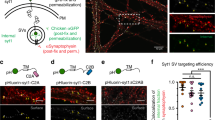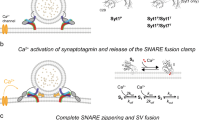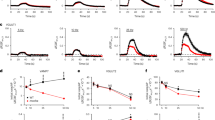Abstract
Ca2+-triggered, synchronized synaptic vesicle fusion underlies interneuronal communication. Complexin is a major binding partner of the SNARE complex, the core fusion machinery at the presynapse. The physiological data on complexin, however, have been at odds with each other, making delineation of its molecular function difficult. Here we report direct observation of two-faceted functions of complexin using the single-vesicle fluorescence fusion assay and EPR. We show that complexin I has two opposing effects on trans-SNARE assembly: inhibition of SNARE complex formation and stabilization of assembled SNARE complexes. Of note, SNARE-mediated fusion is markedly stimulated by complexin, and it is further accelerated by two orders of magnitude in response to an externally applied Ca2+ wave. We suggest that SNARE complexes, complexins and phospholipids collectively form a complex substrate for Ca2+ and Ca2+-sensing fusion effectors in neurotransmitter release.
This is a preview of subscription content, access via your institution
Access options
Subscribe to this journal
Receive 12 print issues and online access
$189.00 per year
only $15.75 per issue
Buy this article
- Purchase on Springer Link
- Instant access to full article PDF
Prices may be subject to local taxes which are calculated during checkout




Similar content being viewed by others
References
McMahon, H.T., Missler, M., Li, C. & Sudhof, T.C. Complexins: cytosolic proteins that regulate SNAP receptor function. Cell 83, 111–119 (1995).
Ishizuka, T., Saisu, H., Odani, S. & Abe, T. Synaphin: a protein associated with the docking/fusion complex in presynaptic terminals. Biochem. Biophys. Res. Commun. 213, 1107–1114 (1995).
Reim, K. et al. Structurally and functionally unique complexins at retinal ribbon synapses. J. Cell Biol. 169, 669–680 (2005).
Pabst, S. et al. Rapid and selective binding to the synaptic SNARE complex suggests a modulatory role of complexins in neuroexocytosis. J. Biol. Chem. 277, 7838–7848 (2002).
Chen, X. et al. Three-dimensional structure of the complexin/SNARE complex. Neuron 33, 397–409 (2002).
Rothman, J.E. Mechanisms of intracellular protein transport. Nature 372, 55–63 (1994).
Brunger, A.T. Structure and function of SNARE and SNARE-interacting proteins. Q. Rev. Biophys. 38, 1–47 (2005).
Jackson, M.B. & Chapman, E.R. Fusion pores and fusion machines in Ca2+-triggered exocytosis. Annu. Rev. Biophys. Biomol. Struct. 35, 135–160 (2006).
Weber, T. et al. SNAREpins: minimal machinery for membrane fusion. Cell 92, 759–772 (1998).
Sutton, R.B., Fasshauer, D., Jahn, R. & Brunger, A.T. Crystal structure of a SNARE complex involved in synaptic exocytosis at 2.4 A resolution. Nature 395, 347–353 (1998).
Poirier, M.A. et al. The synaptic SNARE complex is a parallel four-stranded helical bundle. Nat. Struct. Biol. 5, 765–769 (1998).
Sudhof, T.C. The synaptic vesicle cycle. Annu. Rev. Neurosci. 27, 509–547 (2004).
Jahn, R. & Scheller, R.H. SNAREs–engines for membrane fusion. Nat. Rev. Mol. Cell Biol. 7, 631–643 (2006).
Archer, D.A., Graham, M.E. & Burgoyne, R.D. Complexin regulates the closure of the fusion pore during regulated vesicle exocytosis. J. Biol. Chem. 277, 18249–18252 (2002).
Itakura, M., Misawa, H., Sekiguchi, M., Takahashi, S. & Takahashi, M. Transfection analysis of functional roles of complexin I and II in the exocytosis of two different types of secretory vesicles. Biochem. Biophys. Res. Commun. 265, 691–696 (1999).
Tang, J. et al. A complexin/synaptotagmin 1 switch controls fast synaptic vesicle exocytosis. Cell 126, 1175–1187 (2006).
Xue, M. et al. Distinct domains of complexin I differentially regulate neurotransmitter release. Nat. Struct. Mol. Biol. 14, 949–958 (2007).
Reim, K. et al. Complexins regulate a late step in Ca2+-dependent neurotransmitter release. Cell 104, 71–81 (2001).
Schaub, J.R., Lu, X., Doneske, B., Shin, Y.K. & McNew, J.A. Hemifusion arrest by complexin is relieved by Ca2+-synaptotagmin I. Nat. Struct. Mol. Biol. 13, 748–750 (2006).
Giraudo, C.G., Eng, W.S., Melia, T.J. & Rothman, J.E. A clamping mechanism involved in SNARE-dependent exocytosis. Science 313, 676–680 (2006).
Melia, T.J. Jr. Putting the clamps on membrane fusion: how complexin sets the stage for calcium-mediated exocytosis. FEBS Lett. 581, 2131–2139 (2007).
Yoon, T.Y., Okumus, B., Zhang, F., Shin, Y.K. & Ha, T. Multiple intermediates in SNARE-induced membrane fusion. Proc. Natl. Acad. Sci. USA 103, 19731–19736 (2006).
Xu, Y., Zhang, F., Su, Z., McNew, J.A. & Shin, Y.K. Hemifusion in SNARE-mediated membrane fusion. Nat. Struct. Mol. Biol. 12, 417–422 (2005).
Koh, T.W. & Bellen, H.J. Synaptotagmin I, a Ca2+ sensor for neurotransmitter release. Trends Neurosci. 26, 413–422 (2003).
Takamori, S. et al. Molecular anatomy of a trafficking organelle. Cell 127, 831–846 (2006).
Zampighi, G.A. et al. Conical electron tomography of a chemical synapse: vesicles docked to the active zone are hemi-fused. Biophys. J. 91, 2910–2918 (2006).
Wong, J.L., Koppel, D.E., Cowan, A.E. & Wessel, G.M. Membrane hemifusion is a stable intermediate of exocytosis. Dev. Cell 12, 653–659 (2007).
Thorgeirsson, T.E., Russell, C.J., King, D.S. & Shin, Y.K. Direct determination of the membrane affinities of individual amino acids. Biochemistry 35, 1803–1809 (1996).
Huntwork, S. & Littleton, J.T. A complexin fusion clamp regulates spontaneous neurotransmitter release and synaptic growth. Nat. Neurosci. 10, 1235–1237 (2007).
Arac, D. et al. Close membrane-membrane proximity induced by Ca2+-dependent multivalent binding of synaptotagmin-1 to phospholipids. Nat. Struct. Mol. Biol. 13, 209–217 (2006).
Sun, J. et al. A dual-Ca2+-sensor model for neurotransmitter release in a central synapse. Nature 450, 676–682 (2007).
Saraswati, S., Adolfsen, B. & Littleton, J.T. Characterization of the role of the Synaptotagmin family as calcium sensors in facilitation and asynchronous neurotransmitter release. Proc. Natl. Acad. Sci. USA 104, 14122–14127 (2007).
Rhee, J.S. et al. Augmenting neurotransmitter release by enhancing the apparent Ca2+ affinity of synaptotagmin 1. Proc. Natl. Acad. Sci. USA 102, 18664–18669 (2005).
Stein, A., Radhakrishnan, A., Riedel, D., Fasshauer, D. & Jahn, R. Synaptotagmin activates membrane fusion through a Ca2+-dependent trans interaction with phospholipids. Nat. Struct. Mol. Biol. 14, 904–911 (2007).
Acknowledgements
We thank J. Rizo (University of Texas Southwestern Medical Center) for kindly providing the plasmid for complexin I. T.-Y.Y. thanks C. Joo and J. Ryu for help with preparing illustrations and critical reading of the manuscript. This work was supported by US National Institutes of Health grants (R21 GM074526 to T.H. and GM051290-14 to Y.-K.S.).
Author information
Authors and Affiliations
Contributions
T.-Y.Y., T.H. and Y.-K.S. designed research. T.-Y.Y. and J.D. performed the single-vesicle measurements. X.L. performed protein purification and vesicle reconstitution. S.-M.L. and X.L. performed the EPR analysis. T.H. and Y.-K.S. provided project management and contributed to new reagents and analytic tools. T.-Y.Y., T.H. and Y.-K.S. wrote the paper. All authors discussed the results and commented on the manuscript.
Corresponding authors
Supplementary information
Supplementary Text and Figures
Supplementary Figures 1–9 (PDF 691 kb)
Rights and permissions
About this article
Cite this article
Yoon, TY., Lu, X., Diao, J. et al. Complexin and Ca2+ stimulate SNARE-mediated membrane fusion. Nat Struct Mol Biol 15, 707–713 (2008). https://doi.org/10.1038/nsmb.1446
Received:
Accepted:
Published:
Issue Date:
DOI: https://doi.org/10.1038/nsmb.1446
This article is cited by
-
Complexin I knockout rats exhibit a complex neurobehavioral phenotype including profound ataxia and marked deficits in lifespan
Pflügers Archiv - European Journal of Physiology (2020)
-
Molecular mechanisms of atlastin-mediated ER membrane fusion revealed by a FRET-based single-vesicle fusion assay
Scientific Reports (2017)
-
A new in vitro hemagglutinin inhibitor screening system based on a single-vesicle fusion assay
Scientific Reports (2016)
-
Molecular origins of synaptotagmin 1 activities on vesicle docking and fusion pore opening
Scientific Reports (2015)
-
Complexins: small but capable
Cellular and Molecular Life Sciences (2015)



